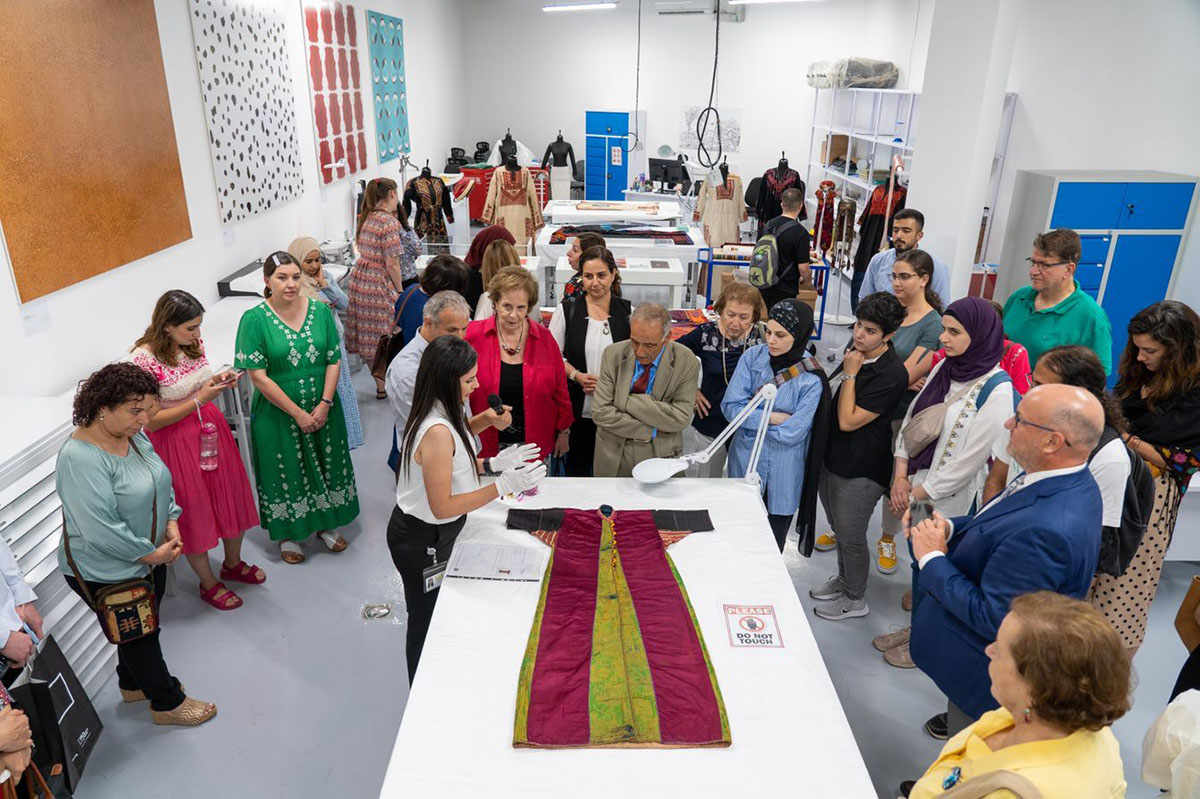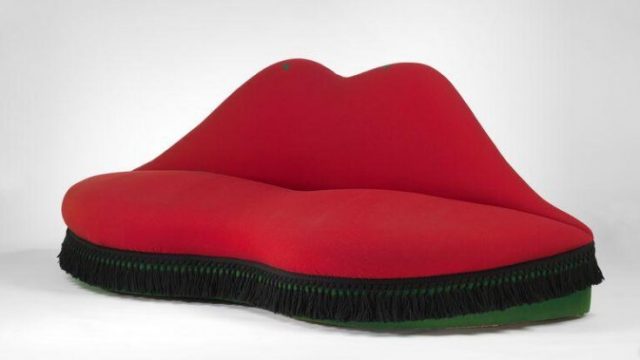This post was written with Katy Smith, Senior Conservator (Textiles)
At the close of 2021 the art of embroidery in Palestine, practices, skills, knowledge and rituals (tatreez), was inscribed to the UNESCO list of the Intangible Cultural Heritage of Humanity. The Victoria and Albert Museum, and the Palestinian Museum in the Occupied West Bank announced a partnership centred on the Palestinian Museum’s recent acquisition of a collection of 80 thobes, traditional embroidered dress.
A major crowdfunding campaign in 2020 had secured the funding to purchase the collection from the Committee for the Preservation of Palestinian Heritage (CPPH) in Washington DC. The thobes made their way to The Palestinian Museum in Birzeit, just outside Ramallah. As part of this undertaking, to develop its facilities and staff expertise around preservation and conservation of its dress collection, the museum then secured a grant from the Swiss-based International Alliance for the Protection of Heritage in Conflict Areas (ALIPH) – with the V&A as a partner.
The tradition of Palestinian embroidery is so richly developed that the provenance of a dress can be established not just to the country, or a region, but to a specific village. With the destruction of villages in Palestine during the Nakba in 1948, the Six-Day war in 1967, and the ongoing occupation, much material culture has been lost or displaced. The work to identify, document, publish and preserve Palestinian heritage is of fundamental importance, both within Palestine, and the rest of the world.

The partnership began with advice on the facilities, furniture and equipment required to kit out a textile conservation studio – it was to be the first in the occupied territories. A rearrangement in the Palestinian Museum created a dedicated space for the storage of the collection, its digitisation and remedial conservation treatments.
The most exciting part of the project came in August 2022, as the V&A South Kensington hosted three colleagues from the Palestinian Museum: Baha Jubeh (Head of Collections Management), Bara Bawatneh (Collections Coordinator and Paper & Textile Conservator) and Salma Abu Mariam (Textile Conservator).

Baha spent a week receiving training from V&A staff across the Collections Care & Access Division, including photography, collections management and technical services. Bara and Salma spent a month in the Textile Conservation Studio learning the fundamental principles and techniques of preventive and interventive conservation. The training programme was designed around the specific context in which the Palestinian Museum exists, under occupation, with logistical problems of purchasing and importing conservation materials; and specifically centred on traditional Palestinian embroidered dress. The V&A holds a small collection of Palestinian costume, and our colleagues from Palestine brought with them 3 pieces to begin work on – two from the Palestinian Museum, and one from Tiraz, the home of Arab dress in Amman.
Bara and Salma spent long hours in the textile conservation studio, systematically learning the methods of documentation, condition checking, surface cleaning, humidification, stitched techniques, dyeing fabric, and costume mounting. They established treatment plans for each of the three dresses, and work began in London, to be completed upon their return.
The knowledge exchange worked in both directions. We spent time with the V&A collection of Palestinian dress, updating the museum catalogue with our new knowledge. Time in the UK meant an opportunity to visit other collections of Palestinian heritage; we made study trips to the British Museum, the Horniman Museum and Whitworth Art Gallery, meeting curators and conservators – fostering a network of specialists. We amended incomplete or inaccurate descriptions of objects, and gathered information. The nature of our collection means that not every object can be fully catalogued, photographed and made available digitally. Research still relies on visiting museums in person and asking to see the collections. The month-long placements ended with a celebratory study day hosted at the V&A, to which our network of Palestinian friends, scholars, and supporters were invited.
Costume has the power to reveal deeply personal, ultimately political, stories. As dresses were lovingly embroidered, worn, repaired, altered, handed down, refreshed and cared for – these actions leave marks that can be read and interpreted today. The last act in the useful life of some of these garments was as they left the hands of refugee women – sold to tourists or collectors and ultimately ending up in a museum. We came across dresses torn through the chest panel, in an act of grief and despair, later stitched closed so the dress could be worn again. We came across dresses with slits cut down the sides of the chest panels for breastfeeding, later stitched closed. We came across dresses dyed deepest blue black with indigo, indicating the period of mourning by the wearer. We saw colour schemes of red, green, black and white – the colours of the Palestinian flag – in an embroidered message of resistance.
Over the course of the following year, the textile conservation studios in South Kensington and Birzeit stayed in close contact, discussing problems and finding solutions for particularly stubborn stains, fiddly stitching, and logistical problems of importing materials. The V&A hosted another colleague from the Palestinian Museum, this time-sharing ideas about the ways of promoting understanding, appreciation and engagement with the craft of tatreez among audiences in the West Bank and around the world.

In July 2023, we were able to pay a return visit to Birzeit, for the inauguration of the Textile Conservation Studio at the Palestinian Museum. This launch was attended by donors, collectors, press and the local museum and cultural community. It included tours of the conservation studio and stores, and it was a chance to see the conservation work up close. It is the museum’s ambition to become a centre of gravity for collectors across the region – to use the facilities and expertise of the museum staff to help them better care for their collections.
The V&A team explored the costume collection, which includes shawls, belts, jewellery and other embroidered objects. We were able to answer technical questions, make assessments for future treatments and carry out more in-person training. The Palestinian Museum’s current exhibition A People By The Sea: Narratives from the Palestinian Coast was wonderful, and we had the privilege of taking a tour of the beautiful landscaped garden, filled with contemporary art.
Returning to London, we reconnected with UK-based activity. Kettle’s Yard in Cambridge is exhibiting Material Power, exploring the historical life and contemporary significance of Palestinian embroidery. The show is curated by Rachel Dedman, the V&A Jameel Curator of Contemporary Middle East. It is a new version of the exhibition Labour of Love that she curated for the Palestinian Museum in 2018.
This exhibition will travel to the Whitworth Gallery in Manchester in November 2023.To coincide with the opening, the V&A is collaborating with colleagues at the Whitworth to stage a symposium showcasing research and contemporary debate on Palestinian embroidery. It will be an opportunity for us to celebrate the completion of this stage of our partnership with the Palestinian Museum – the networks, and friendships we have built along the way – and to think towards opportunities for working together on future collaborations.



Well done, fantastic work by V&A